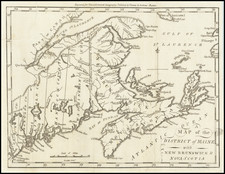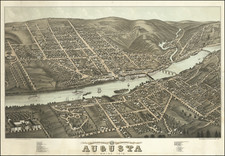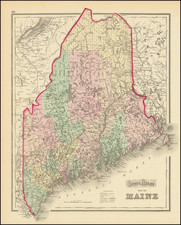Unrecorded Mount Desert Island Proof Sheet
Detailed chart of a large portion of Mount Desert Island, which appears almost certainly to be George Davidson's copy of a proof sheet showing the progress of the mapping and surveying of the region in the early 1880s.
Bearing the stamp at the lower right corner of the US Coast & Geodetic Survey and de-accessioned in 1964 by the University of California Map Collection, the map was almost certainly part of the collection of the famed American mapmaker George Davidson (see biographical data below), one of the most important mapmakers and scientific minds of the 19th Century, who gave his map collection to the University of California in the early part of the 20th Century.
The proof nature of the chart would seem to be borne out by the meticulous grid lines drawn onto the map, the 3 orientation lines shown on the soundings at the bottom right part of the chart, and the large open rectangle at the bottom right, seemingly left for the insertion of text. Similarly, the top right and left sections of the map sheet clearly appear unfinished, perhaps in conjunction with work being done by J.E. Hilgard in 1883, although we have not been able to identify the map.
We surmise that the map was intended as the eastern sheet of a 2-sheet map.
At the time the chart was created, Davidson working for the United States Coast Survey, and was then in charge of the main triangulation and astronomical work on the west coast (1876-1886). During this time, his geodesy work was widely regarded as unsurpassed within the US Coast Survey.
Rarity
The chart is apparently unrecorded.
Provenance: Warren Heckrotte, sold by PBA Galleries in 2023.
George Davidson (1825-1911), was one of the most important mapmakers and scientific minds of the 19th Century.
Davidson was born in England and moved to the US in 1832. He met Alexander D. Bache in 1842, when he assisted Bache in his observations of the magnetic elements at Girard College. Upon his graduation in 1845, he began his career as clerk to Bache who was superindentent of the United States Coast Survey.
From 1846 to 1850, Davidson was occupied in geodetic field work and astronomy on the east coast. In 1850, he went to California, where he was engaged in the determination of the latitude and longitude of prominent capes, bays, etc., and of the magnetic elements of the Pacific Coast, including a survey of Washington and Puget sounds, and the main triangulation of the coast in the region of San Francisco.
From 1861 to 1867, he was again on the Atlantic seaboard, principally engaged in engineering work on coast and river defences. In 1866, he became chief engineer of an expedition for the survey of a ship canal across the Isthmus of Darien.
In 1867, he was appointed to make a special examination and report upon the geography and resources of Alaska, pending its purchase; his published report and conferences with congressional committees influenced the passage of the bill. He was placed in charge, during 1867, of the work of the Coast Survey on the Pacific, planned work for the land parties from 1868 until 1875, and inspected all the fields of work.
From 1876 to 1886, he had charge of the main triangulation and astronomical work on the west coast; the records of the computing division showed that the results of his observations stood higher than any ever executed in America, Europe, or India, and they were characterized as “unique in the history of geodesy.
In 1881, Davidson twice measured the Yolo base line, one of the geodesic base lines that formed the foundation of triangulating distances in California. At that time, it was the longest base line yet attempted in trigonometrical operations, and the system of triangulation directly connected therewith was called in his honor the “Davidson quadrilaterals.” He also measured the Los Angeles base line three times in 1888-1889. He retired from the Coast Survey in 1895, after 50 years of service.
Davidson also founded the Davidson Observatory in San Francisco, which was the first astronomical observatory on the Pacific coast of North America, and in 1869 brought the Pacific geodetic of the coast survey in telegraphic longitude connection with Greenwich. His astronomical work includes the observation of the total solar eclipse under the 60th parallel, in 1869; determination of the 120th meridian in 1873; charge of the U. S. transit of Venus expedition, in 1874; recovery of the transit of Venus station of 1709 in Lower California occupied by Auteroche de la Chappe; observation of the total solar eclipse of January 7, 1880; and in 1882 charge of the party to observe the transit of Venus in New Mexico.
Other positions held by Davidson include president of the California Academy of Sciences from 1871 to 1887, Honorary Professor of Geodesy and Astronomy, and Regent of the University of California from 1877 to 1885. After his retirement from the Coast Survey,[4] he became the first professor of geography at the University of California, Berkeley, and chaired that department from 1898 until his retirement in 1905, and remained an emeritus professor until his death. Davidson was one of 182 charter members of the Sierra Club in 1892 and served as a member of its board of directors from 1894 to 1910.












![[ Cape Cod to Acadia ] Pas-Kaart Vande Zee Kusten inde boght van Niew Engeland Tusschen de Staaten Hoek en C.de Sable . . .](https://storage.googleapis.com/raremaps/img/small/94453.jpg)

![[ Mount Desert Island -- Proof Sheet -- George Davidson Copy ]](https://storage.googleapis.com/raremaps/img/small/101360.jpg)

![[ The Finest Colonial New England Sea Chart of the 18th Century ] The Coast of New England](https://storage.googleapis.com/raremaps/img/small/63672.jpg)